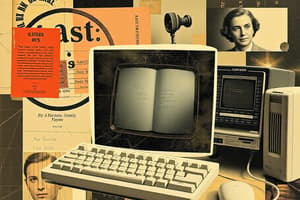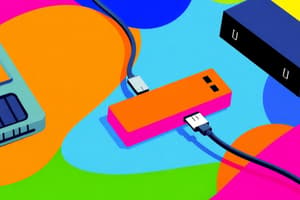Podcast
Questions and Answers
Which type of video display terminal uses traditional cathode ray technology?
Which type of video display terminal uses traditional cathode ray technology?
- CRT (correct)
- Dumb terminal
- Plasma screen
- LCD
A drum plotter is a type of input device.
A drum plotter is a type of input device.
False (B)
What is the primary function of Computer Output Microfilm (COM)?
What is the primary function of Computer Output Microfilm (COM)?
To record data as microscopic images on film.
A _______ is an example of a pointing device.
A _______ is an example of a pointing device.
Match the following devices with their primary use:
Match the following devices with their primary use:
Which of the following are considered output devices?
Which of the following are considered output devices?
Voice recognition technology requires no pre-stored vocabulary to function effectively.
Voice recognition technology requires no pre-stored vocabulary to function effectively.
What type of data input is characterized by direct transfer to the computer?
What type of data input is characterized by direct transfer to the computer?
The device used for writing or sketching directly on screens is called a ______.
The device used for writing or sketching directly on screens is called a ______.
Match the following input devices with their functions:
Match the following input devices with their functions:
Which of the following is a disadvantage of punch cards?
Which of the following is a disadvantage of punch cards?
Digital cameras are an example of input devices.
Digital cameras are an example of input devices.
Name one advantage and one disadvantage of voice recognition technology.
Name one advantage and one disadvantage of voice recognition technology.
Flashcards
Flatbed Plotter
Flatbed Plotter
A device used for creating graphs and drawings on a flat surface. It uses a movable pen or stylus to draw lines on paper or another medium.
Video Display Terminal
Video Display Terminal
A computer peripheral that displays information visually on a screen. Examples include CRT monitors and flat-panel displays like LCD and plasma screens.
Computer Output Microfilm (COM)
Computer Output Microfilm (COM)
A type of output device that records data as microscopic images on a photographic film. It provides a compact and high-speed way of storing large amounts of data.
Magnetic Ink Character Recognition (MICR)
Magnetic Ink Character Recognition (MICR)
Signup and view all the flashcards
Optical Character Recognition (OCR)
Optical Character Recognition (OCR)
Signup and view all the flashcards
Peripheral Devices
Peripheral Devices
Signup and view all the flashcards
Input Devices
Input Devices
Signup and view all the flashcards
Output Devices
Output Devices
Signup and view all the flashcards
I/O Interfaces
I/O Interfaces
Signup and view all the flashcards
On-line Data Input
On-line Data Input
Signup and view all the flashcards
Off-line Data Input
Off-line Data Input
Signup and view all the flashcards
Keyboard
Keyboard
Signup and view all the flashcards
Mouse
Mouse
Signup and view all the flashcards
Study Notes
Chapter 2: Input and Output Devices
- Peripheral devices facilitate communication between the computer and the external world
- Input Devices supply data/programs to the computer (e.g., keyboard, mouse)
- Output Devices relay computer-generated information to users or storage (e.g., monitors, printers)
- I/O Interfaces convert input data into machine-readable form, and output into human-readable form
- Data Input Methods include On-line (direct transfer) and Off-line (data prepared and entered later)
2.2 Input Devices
2.2.1 Punch Cards
- Data stored in cards using codes (e.g., Hollerith Code)
- Advantages: Cheap, reliable
- Disadvantages: Not reusable, require careful handling and large storage.
2.2.2 Keyboard
- Standard input device; easy to use, inexpensive
- Keys: Letters, numbers, special functions (e.g., F1-F12, arrow keys)
- Allows efficient data editing
2.2.3 Mouse
- Pointing device for cursor movement
- Types: Mechanical, optical, optical-mechanical
- Used for writing/sketching on screens
2.2.4 Light Pen
- Used for writing/sketching on screens
- Applications: CAD
2.2.5 Joystick
- Converts movement into digital signals; used in gaming
2.2.6 Trackball
- Sphere-based device for cursor control
2.2.7 Touchscreen
- Transparent plate over CRT; registers touch input
- Types: Optical and electric
2.2.8 Digitizer
- Converts graphical/pictorial data into digital form
- Types: Image scan and flatbed digitizers
2.2.9 Scanner
- Types: Optical (OMR, OCR) and Magnetic Ink Character Recognition (MICR)
- Reads text/images directly into memory
2.2.10 Voice Recognition
- Converts speech to electrical signals
- Advantages: Reduces data entry cost, operator mobility
- Disadvantages: Operator-dependent, requires pre-stored vocabulary
2.3 Output Devices
2.3.1 Printers
- Impact Printers: Use mechanical hammers (e.g., dot matrix, daisy wheel, line printers)
- Non-Impact Printers: Use modern technologies (e.g., inkjet, laser)
2.3.2 Plotter
- For graphs/drawings
- Types: Flatbed (X-Y) and Drum
2.3.3 Video Display Terminal
- Types: CRT, Flat Panel Display (e.g., LCD, plasma screens)
- Terminal types: Dumb, smart, intelligent
2.3.4 Computer Output Microfilm (COM)
- Records data as microscopic images on film
- Advantages: Space-efficient, high-speed
- Disadvantages: Expensive, sophisticated
2.4 Summary
- Peripheral devices are categorized into input and output types
- Input devices capture user data (e.g., keyboards, mice, scanners)
- Output devices present processed data (e.g., printers, monitors)
- Advanced I/O devices enhance interaction and efficiency
2.5 Questions for Self-Study
- Fill in the blanks: Example of a picking device, pointing device, digitizer
- Give full forms: MICR, OCR, OMR
- Match the following: Punch card - Hollerith Code, Bar code- Universal Product Code, Joystick- Computer games, Floppy Disk - Output devices.
- Short answers: Define terminal and list types, What is an impact printer? Name an example.
Studying That Suits You
Use AI to generate personalized quizzes and flashcards to suit your learning preferences.




